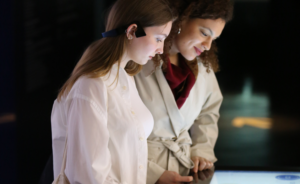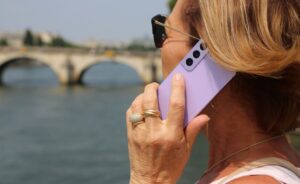Blog

Localization technologies for indoor audio guides: optimization of the visitor experience
Introduction: the essential role of indoor localization for audio guides
Audio guides have profoundly transformed the visitor experience in museums, art galleries and other cultural venues. Thanks to technological advances, these devices now offer a personalized immersion based on the visitor’s position. Indoor location technology is at the heart of this evolution, making it possible to determine the exact location of visitors and trigger content adapted to their immediate environment.

These technologies offer unprecedented navigation and interaction possibilities, making the visit more fluid and engaging. To understand the impacts of these technologies on the visitor experience, it is essential to know the different indoor location methods used in modern audio guides, such as Bluetooth Low Energy (BLE), Infrared, Ultra- Wideband (UWB), QR codes, marker numbers and recognition of works of art.
Bluetooth low energy (ble): a versatile technology
Bluetooth Low Energy, or BLE, is widely used for indoor location tracking thanks to its ability to transmit data over short distances while consuming very little power. BLE beacons are placed in strategic locations in museums, emitting signals picked up by audio guides to estimate the visitor’s position with an accuracy of a few meters.
One of the major advantages of BLE is its low energy consumption, which extends the autonomy of beacons and audio guides. Additionally, this technology is relatively inexpensive to install and maintain, as BLE beacons are compact and easy to conceal in the environment, without requiring significant structural modifications. They are precise enough for museums and galleries where exact proximity within a few meters is usually adequate.
However, BLE has some limitations, including its susceptibility to interference from other Bluetooth devices or physical obstacles like thick walls. This interference can affect location accuracy, and maintenance of the beacons, although simple, requires regular checks to ensure they are functioning properly.
Infrared technology: precision and simplicity
Infrared technology, although less common today, remains an effective method for indoor location. It works by using infrared transmitters which send signals picked up by the audio guides. Unlike radio waves, infrared signals require a direct line of sight, which ensures high accuracy in detecting the visitor’s position.
One of the main advantages of infrared is its ability to offer extremely precise localization, which is particularly useful in environments where several works are close to each other. In addition, infrared consumes very little energy, which extends the autonomy of the audio guides. This relatively simple technology has been proven and used for many years in various contexts.
However, the need for a clear line of sight between transmitter and receiver can pose challenges, particularly in environments where the layout of works changes frequently or in cluttered spaces. Additionally, the limited range of infrared may require the installation of a large number of emitters to cover large spaces, thereby increasing installation costs.
Ultra-wideband (uwb): extreme precision
Ultra-Wideband (UWB) is an indoor location technology offering unrivaled accuracy. This technology uses extremely wide bandwidth to transmit data, making it possible to locate a visitor with an accuracy of a few centimeters. In museums, UWB can track visitors’ movements in real time with remarkable accuracy, triggering audio content specifically tailored to their location.
The exceptional precision of UWB makes it an ideal technology for environments where accurate localization is crucial. Additionally, UWB is less prone to interference than other technologies, ensuring stable performance even in complex environments.
However, this precision comes at a cost. UWB is more energy intensive, which can considerably reduce the autonomy of audio guides. Devices using this technology are also more expensive to produce and install, and require advanced technical expertise for implementation. As a result, UWB is often reserved for applications where precision is absolutely essential.
QR codes: simplicity and accessibility
QR codes represent a simple and economical solution for providing information via audio guides. Placed next to works or in specific sections of the museum, visitors can scan these codes with their device to access digital content directly linked to the work in question.
The major advantage of QR codes is their ease of use. The majority of smartphones are equipped with cameras capable of scanning QR codes, allowing visitors to receive information without requiring additional devices.
However, the use of QR codes also has limitations. It relies entirely on the visitor’s initiative to scan the codes, which can result in a less immersive and less fluid experience. In addition, this method does not allow real-time localization or tracking, which limits interaction and immersion compared to other technologies.
Marker numbers: a reliable traditional method
Cue numbers are a traditional and proven method of providing information via audio guides. Numbers are placed next to the works, and visitors manually enter them into their audio guide to listen to the corresponding explanations. This method, although old, remains widely used for its simplicity and reliability.
The simplicity of the reference numbers makes it an accessible method without the risk of technical failure. It does not require any complex installation or advanced technology, which minimizes installation and maintenance costs. Additionally, this method is particularly energy efficient, as it relies solely on manual entry by the visitor.
However, the lack of automatic localization is a major drawback of this method. The visitor must remember to enter the number of each work, which can make the experience less fluid and engaging. Compared to modern solutions, this method offers less interactivity and does not take full advantage of the possibilities offered by location technologies.
Recognition of works of art: AI at the service of immersion
Art recognition is an innovative technology using artificial intelligence (AI) to automatically identify the works the visitor is viewing. By pointing their device at a work, visitors can instantly access contextualized and enriched information, making the experience more immersive and interactive.
This technology allows for a smooth and intuitive interaction, where the visitor does not need to manually enter information or scan codes. AI can also personalize the experience based on visitor preferences, offering additional details or recommendations based on their interest.
However, recognizing works of art requires significant computing power, which reduces the autonomy of audio guides. Additionally, the accuracy of this technology depends on the quality of images captured by the visitor’s device and may require a stable internet connection to access a database of works. Finally, setting up and maintaining such a system can be expensive, requiring robust infrastructure and regular updates.
Choosing the right technology for an optimal experience
Localization technologies for indoor audio guides offer a wide range of possibilities to enrich the visitor experience. Each technology has its advantages and disadvantages, particularly in terms of precision, interactivity and energy consumption. Choosing the most suitable technology depends on the specific needs of the site, the available budget, and the desired user experience.

While some technologies like UWB and AI-based art recognition offer increased accuracy and interactivity, they have a significant impact on power consumption and costs. Others, like QR codes and marker numbers, are more economical and simple to implement, but offer less immersion.
Ultimately, it is essential to find a balance between accuracy, interactivity and energy efficiency to provide visitors with an enriching and memorable experience, while ensuring the sustainability and efficient management of the devices used.





